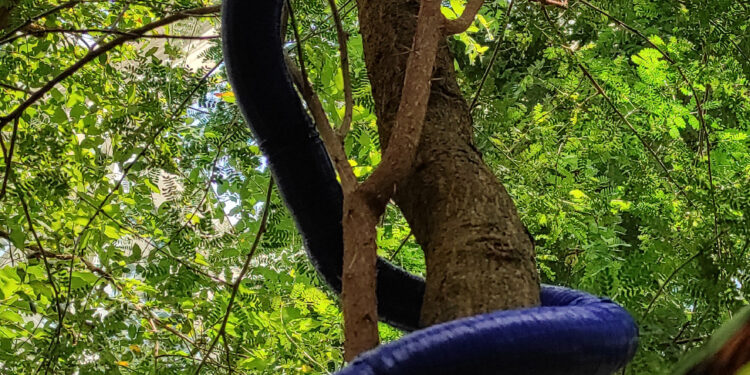FiloBot mimics and represents skototropisms, involving growth directed toward shaded areas under leaves. Credit: Scientific robotics (2024). DOI: 10.1126/scirobotique.adi5908
A trio of soft robotics researchers from the Fondazione Istituto Italiano di Tecnologia, Italy, in collaboration with a colleague from the University of Montpellier, France, have developed a unique type of robot that 3D prints its own body to grow taller a long time. In their article published in the journal Scientific roboticsthe group describes how they created their robot and the possible uses for it.
As science and technology advance, scientists find new ways to combine innovations to create new types of technologies. In this new effort, the research team combined robotics with 3D printing, resulting in the creation of a new type of robot that can stretch at will.
The robot is shaped like a snake and has a rotating head. As the head rotates, it creates more body mass behind it through 3D printing, causing the robot to lengthen. The robot can also be programmed to grow in any desired way, such as towards light or against gravity. This gives the robot the ability to grow like a vine. The team named their robot FiloBot.
FiloBot has a tube inside its body that feeds the head, which contains 3D printer ink, a type of plastic. The head then prints in a rotary manner, rolling the body material behind it. At the opposite end, at the back of the robot, is a base containing the inkwell, a pump, and a power source.
Inside the head, as well as the printer, are electronic components that respond to signals from sensors located on an exterior part of the head. Sensor inputs are used to control the printer’s output: they are able to speed up or slow down its rotation speed and the amount of ink supplied. This helps control the direction of growth.
The researchers suggest that possible uses for their robot include monitoring or even interacting with unstructured (natural) environments or building autonomous structures. It could also be used to monitor landscapes to estimate the likelihood of avalanches or landslides and test pollution levels in hard-to-reach areas.
-
Simplified representation of growth zones, their functions and growth responses. The shoot apex includes layers of cells that constitute the meristematic part (point 1) and the region of cell elongation (point 2). Photoreceptors and gravity-sensitive cells are distributed at the top of the shoots. The perception of external signals is thus localized in the apical part, where actuation is also implemented. Processing of an external stimulus dictates cell growth, elongation, and the resulting orientation of the shoot. In the example, photo-perception defines the movement of the shot towards the light merged with the perception of gravity against gravity. Credit: Scientific robotics (2024). DOI: 10.1126/scirobotique.adi5908
-
Schematic representation of growing robotic regions, their functionalities, and responses to growth. Analogously at the top of the shoot, the robot includes detection elements and a material deposition region located at its head (points 1 and 2). In the meristem-like region, there is an addition of material and the generation of forces necessary to propel the tip forward. Plot control defines a lower or upper layer of material along the stem axis, analogous to differential cell division and elongation. By analogy with the biological model, the robot processes sensory inputs and defines a differential deposition of material both towards light and against gravity. In natural and artificial models, the already developed body part no longer moves or reorients itself in relation to the environment. Credit: Scientific robotics (2024). DOI: 10.1126/scirobotique.adi5908
More information:
Emanuela Del Dottore et al, A growing soft robot with adaptive behaviors inspired by climbing plants for navigation in unstructured environments, Scientific robotics (2024). DOI: 10.1126/scirobotique.adi5908
© 2024 Science X Network
Quote: New snake-like robot 3D prints its own body to lie down (January 19, 2024) retrieved January 19, 2024 from
This document is subject to copyright. Apart from fair use for private study or research purposes, no part may be reproduced without written permission. The content is provided for information only.



